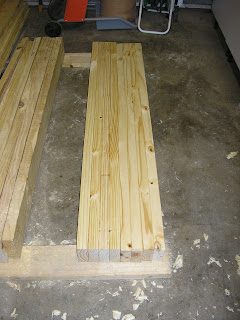The smaller projects that have been occupying my time of late have finally been completed, so it was back to the Roubo this weekend.
I glued up the final lamination after having purchased an additional board to obtain my finished width of 600mm. This basically entailed jointing and planing the boards square and gluing up. Some preliminary flattening was done with the handplanes in order to obtain a reasonable flatness to put through the thicknesser.
The first lamination presented somewhat of a challenge in that I had ripped the boards pretty close to finished width. Not only did I have precious little material to play with, I also discovered this lamination to be significantly in wind. At this point I was quite prepared to scrap this assembly and remake it. Since the lumber yard was closed for the long weekend, I decided to see what could be done to salvage it. So it was back to work with the jointer plane and winding sticks to obtain some degree of flatness again, while at the same time preserving as much of the material as possible to ensure the finished thickness of 100mm.
 Having completed this task, I put each of the laminations through the thicknesser in order to obtain the finished thickess of 100mm.
Having completed this task, I put each of the laminations through the thicknesser in order to obtain the finished thickess of 100mm. I was concerned at the Ryobi's ability to handle such a wide board - this proved to be unfounded, as it performed the task without flinching.
I was careful to ensure that my outfeed roller was well positioned to catch the boards as they passed through the machine.
My finished thickness ended up at 98mm - because of the inaccuracies of the first lamination. All things considered though, this is not a bad margin of error on boards of this length, width and weight!
The top is starting to take on a beefy appearance. At this stage it looks as though you could park a small car on it and not have it deflect!
The next step in the process will be to joint the edges of each lamination. This will facilitate the assembly of the top and ensure that the laminations pull together square. Because of the size of each lamination, it will be impossible for clamping pressure alone to ensure a tight glue line, so the edges will have to be jointed perfectly prior to glue up. This is scheduled to take place next weekend.
Following on from that, I will begin construction of the legs and stretchers - and then it's assembly time!









